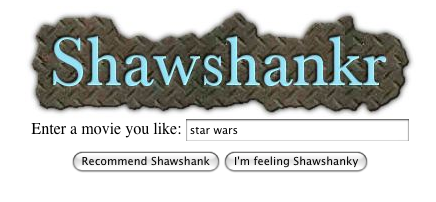Friday Nov 21, 2008
Monday Nov 17, 2008
We've seen a few commercial music recommenders that rely on
content-based techniques - MusicIP, Echo Nest, Ghanni, One Llama,
Audiobaba, Owl, SoundFlavor and Pandora have all had some aspect of
content-based recommendation at the core of their systems. Now there's
another content-based recommender to add to the list of contenders -
mufin. 
Mufin (which stands for MusicFinder) is a content-based recommender that (according to Techcrunch) is an offshoot of Fraunhofer (the folks who invented the MP3). Given this pedigree, I had very high expectations for Mufin.
The Technology
From the Mufin Technology page:
- mufin uses mathematical extraction of specific details from a
music title to create an objective desciption of the title’s
characteristics which is independent of human influences. Using this
description, songs which are similar to one another can be filtered out
of a large database. Rhythmical characteristics (e.g. intensity of the
rhythm, tempo, percussion in the piece), sound colour, harmonic and
melodic qualities are weighted differently for the result.
My Impressions
I was lucky enough to get a invitation to the Mufin private beta - so I took it for a spin - here are my impressions.

The Mufin site is very simple to understand. It has a classic search box where you can search for an artist, album or track. Since there are nearly 5,000,000 tracks in the catalog you are bound to find what you are looking for. I searched for bands like Deerhoof, ELP, The Beatles, Hannah Montana, The Feelies, and the Rheostatics. Mufin had them all. Unfortunately, Mufin won't let you play back all of the songs in the catalog - some songs can be played all the way through, some you can play 30 second excerpts, and some are not playable at all - this is, no doubt due to the crazy licensing issues that plague digital music. Mufin also lets you purchase tracks from iTunes - (allowing Mufin to make some money via referrals).
The Recommendations
Of course, searching for music is no big deal - what we are interested in are the content-based recommendations. So lets check them out.Whenever I try out a new content-based recommender, the first track I usually try is Revolution #9 by the Beatles. This is a good way to find out if a recommender is really a CF recommender trying to pose as a content-based recommender. Revolution 9 is so unlike any other Beatles song (or any other Rock or Pop song recorded in the 70s) - that recommendations from a content-based recommender will yield very different results than what you'd get from a CF recommender. Using Mufin to find music similar to Revolution #9 yielded a rather strange grab bag of music: Some Wagner, Engelbert Humperdink, UFO, Gershwin, The Disney Aladin Soundtrack, Frank Sinatra, and Ella Fitzgerald. No 70s pop, which is a good sign, but the results seemed to be strongly under the influence of a random number generator. Not a very good start - but since Revolution #9 is not your typical track perhaps these results were an aberration.
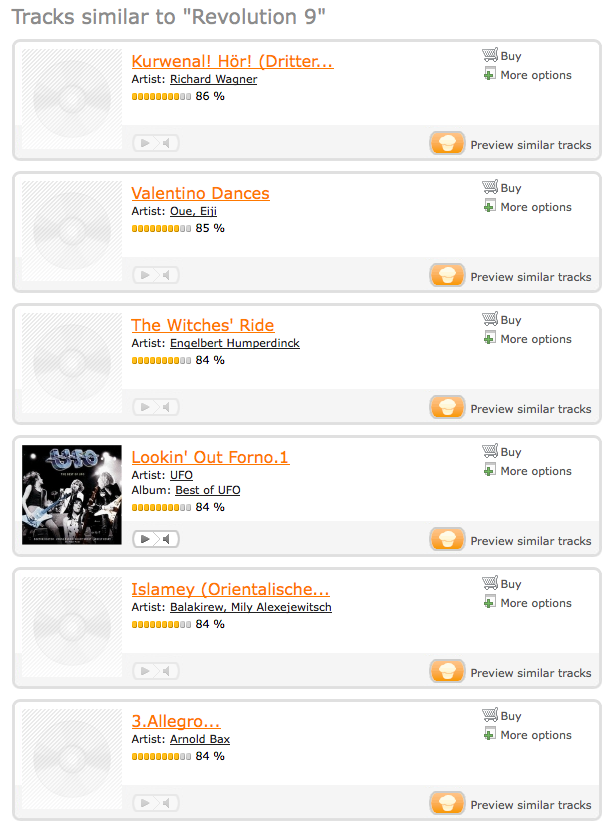
So I moved on to something a bit more conventional - some power pop with from Weezer. I tried the track 'My Name is Jonas'
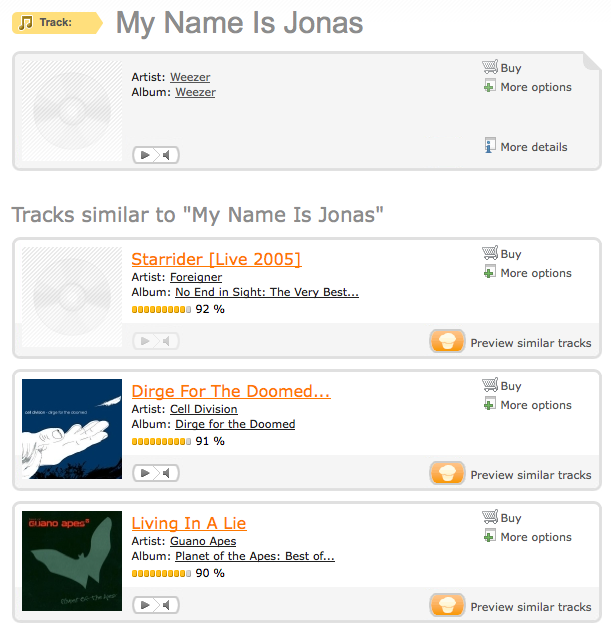
These results looked better with tracks by Foreigner, Cell Division, Guano Apes, Dream Theater. However, there was also quite a bit of heavy metal - Rhapsody, Kamelot, Dio - that didn't really seem to fit to well.
Next up was some cool jazz - Take Five by Dave Brubeck. For similar tracks I did get some cool jazz like McCoy Tyner, but also some salsa, some crash test dummies, some blues by McCracklin and Louisiana Red (good stuff, but not anywhere near the cool jazz and syncopated rhythms of Brubeck), some female vocalist/country music by Frances Black, Gospel music by the Jackon Southernaires. Again it seemed like the random number generator was working overtime on this set of recommendations.
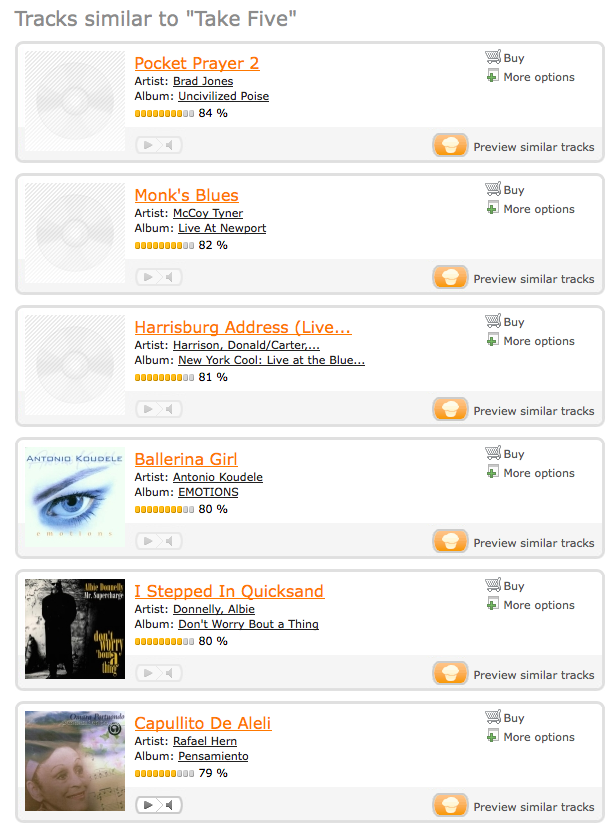
Next up was Led Zeppelins venerable classic Stairway to Heaven:
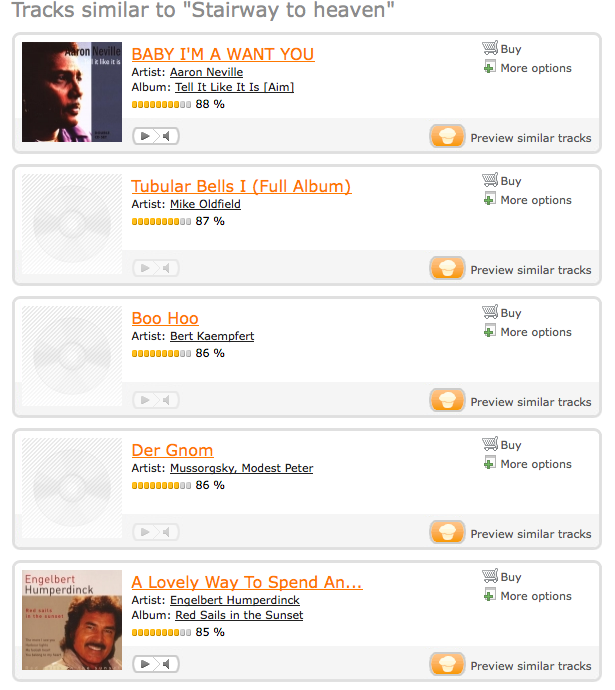
The recommendations included soul music by Aaron Neville, minimalist electronica (tubular bells), classical piano (Mussorgsky), easy listening (Englebert Humperdink, Paul Anka). There was no need to 'get the led out' of this list. One has to wonder about a recommender that puts Engelbert Humperdink in the same list as Mussorgsky's Pictures at an Exhibition.
Finally I tried some classical music - with Beethoven's Fifth symphony.
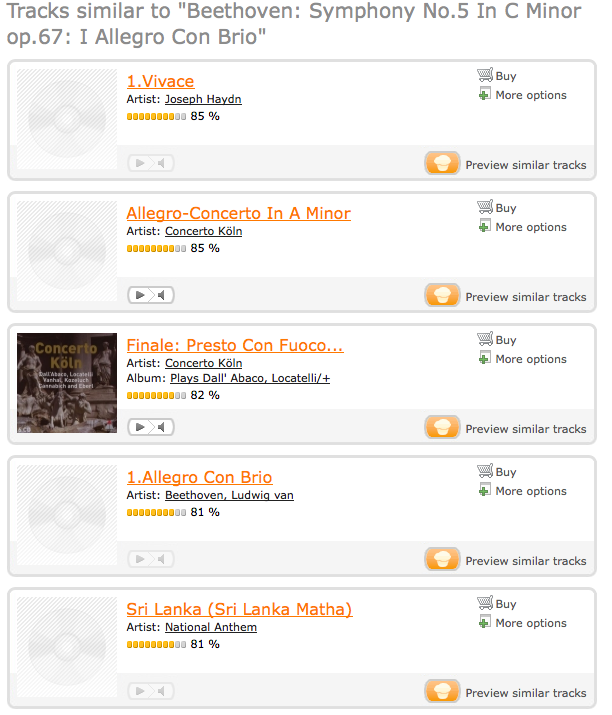
These recommendations seem to be much better - the recommendations include some more Beethoven, there's Hayden, Handel, Tschaikovksy, Mozart, Chopin, Dvorak and a number of classical film scores.
Summmary
The Mufin folks have done a good job putting together the Mufin site. They've indexed an incredible amount of music. The search engine and the recommender engine are fast. The site design is clean, and easy to use. However, the content-based recommendations provided by Mufin don't fair well when compared to the type of recommendations one can get from a CF filtering recommender. There is a very high rate of 'clunker' tracks that no human would ever recommend based upon the seed track. For some seed tracks, the recommendations seemed no better than shuffle play -while for others especially classical, the recommendations seemed to be pretty good.The Mufin team are working hard to improve their recommendations - I hope they get the kinks out - it would be nice to see long tail, content-based recommendation become a reality.
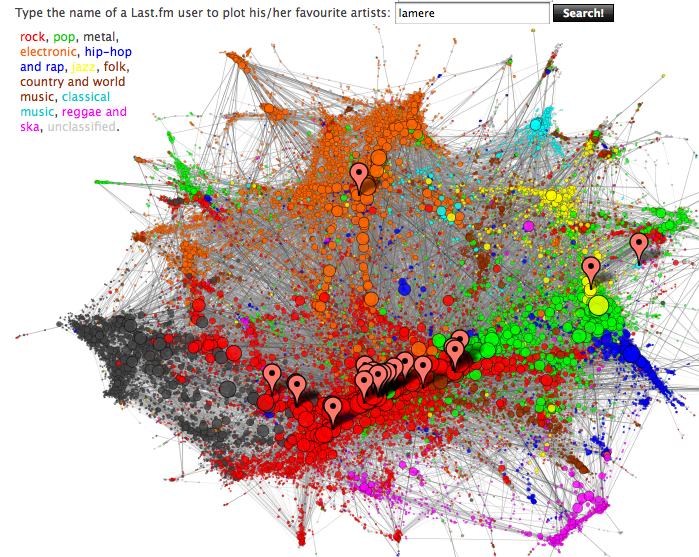 .
.
Update: There's a super-zoomable version on the seadragon gallery page. I can't figure out how to directly link to the image ... It is the 5th one from the right. The plot is created by crawling the similar artist graph of Last.fm (starting with Nightwish of all places) using the last.fm audioscrobbler webservices. The artists are arranged on the graph using a DrL graph layout algorithm (DrL is a force-directed layout algorithm that works with very large data sets. More info about this algorithm can be found in this paper ). The nodes in the graph are colored based upon the most frequent tags, while the edges are colored based upon their 'betweeness centrality score'. The area of a node in the graph is approximately proportional to the popularity of the artist.
Nepusz has also created an interactive map that allows you to type in the name of a few artists to see where they live on the map - or you can just enter your last.fm user name and it will show you where all your favorite artists are in the world of music.
The layout algorithm does a pretty good job of showing the large scale structure of the artist space. Artists with similar genre tags are well clustered. The ability to see where a particular artist is located on the map is very nice and the last.fm user integration is particularly sweet. Interesting too, is how the popular artists seem to be clustered in the graph. The larger vertices in the red-rock area form a very tight line. This may be an effect of using the Last.fm artist similarity which has a popularity bias (the top 10 artists similar to the beatles are all very popular artists).
What I really wish I could do is to use these plots for music discovery -
I'd like to be able to mouse over a vertex to see what the band is (and
even be able to listen to the band). It would be really interesting,
for instance, to explore the point where the electronic and the rock
world meets (like in the subsection of the graph shown here on the left -
what artist is represented by the large orange node?).  It'd be interested to see what the outliers are (I wonder what this
reggae/ska artist is doing near the jazz, as seen in the subgraph on the
right).
It'd be interested to see what the outliers are (I wonder what this
reggae/ska artist is doing near the jazz, as seen in the subgraph on the
right).  I'd like to be able to zoom in and see some of the finer structure (if I
zoom in on the Nightwish neighborhood, do I find more finnish, gothic
metal?).
I'd like to be able to zoom in and see some of the finer structure (if I
zoom in on the Nightwish neighborhood, do I find more finnish, gothic
metal?).
I'm a sucker for such visualizations, I think they can be a powerful tool for helping people to understand and explore a music space, and they can reveal relations and structure that are not evident in simple lists of similar artists. But creating these visualizations are not easy. Without special care they can easily turn into meaningless blobs. Nepusz has done an excellent job finding the right embedding algorithm, color and sizing strategy for the data. I hope he continues to add interactivity to his plots. Well done.
Saturday Nov 15, 2008

Ge Wang is a really smart energetic guy. While at the ISMIR conference this year, I sat next to Ge at dinner - he showed me his first iPhone app: SMule's Sonic Lighter:
Since then, Ge has created another very popular iPhone app called the Ocarina:
Ge as been very busy.
Thursday Nov 13, 2008
I'll be giving a short talk called Stairway to Muskrat Love - If you like Led Zeppelin, you might like Captain & Tennille that describes some of the work we've done here in SunLabs (My talk title seems to be considerably less formal than the other talks on the schedule, sigh).
I'm particularly looking forward to the poster session (and not just for the wine ad cheese) - there are posters being presented by students from UdeM, Columbia, and McGill. It should be a fun day - and hopefully worth the 4AM departure time (3:30AM for Steve!) and the 10 hours of driving.
Sunday Nov 09, 2008
 iLike now has a developer platform that lets you embed the iLike player in a web page and play just about any song on demand. There are three main functions:
iLike now has a developer platform that lets you embed the iLike player in a web page and play just about any song on demand. There are three main functions:
- iLikeDisplaySong - displays/plays a single song
- iLikeSongChooser - search and select a song
- iLikeDisplayPlaylist - to display/play a playlist
The code for displaying a song is straightforward - just include some iLike javascript and away you go. For instance to play a song, use the code:
<script>
iLikeDisplaySong({elId: "song1", songName: "roundabout", artistName: "yes"});
</script>
APIs that make it easy for 3rd parties to embed music, like this iLike
API are going to really help new music exploration and discovery
companies connect people with music.
Via Doubtful Sound.
Friday Nov 07, 2008

Georgia Tech today launches the new Center for Music Technology with more than 20 researchers from the arts, sciences and engineering. Several interdisciplinary projects already in progress were demonstrated today at a launch event for potential collaborators.
There's lots of interesting things to see on at the GTCMT website, including ZooZBeat
Flou - (pronounced "flew") is not exactly a game; you do fly a ship through space, but you cannot shoot anything, score points, or win or lose. The focus, rather, is on the soundtrack: as you navigate through a 3D world and zoom through objects in space, you add loops and apply effects to an ever-evolving musical mix.
They are doing some interesting work around music and emotion: Statistical Learning and Expectation Evoked Emotion, Emotion in Raag, and Basic Auditory Cues for Emotion
A number of researchers from GTCMT have been active in the MIMR community including Parag Chordia, Mark Godfrey and Alex Rae. I particularly enjoyed their work presented at ISMIR this year around Content-based Recommendation - Hubs and Domain-specificity
Wednesday Nov 05, 2008
The Shawshankr was created by my colleague, Jeff - who deserves all the credit and praise for this wonderful system.
-
1. Marvin Gaye, "Ain't No Mountain High Enough''
2. John Parr, "St. Elmo's Fire (Man in Motion)''
3. Tina Turner, "The Best''
4. The Doobie Brothers, "Takin' It To The Streets''
5. Earth, Wind & Fire, "Shining Star''
6. O'Jays, "Give The People What They Want''
7. Sam and Dave, "Hold On I'm Coming''
8. Kool & the Gang, "Celebration''
9. Natasha Bedingfield, "Unwritten''
10. The Isley Brothers, "Shout''
11. The Temptations, "Get Ready''
12. India.aire, "There's Hope''
13. McFadden and Whitehead, "Ain't No Stoppin' Us Now''
14. Staples Singers, "I'll Take You There''
15. Orleans, "Still The One''
16. Sly and the Family Stone, "Everyday People''
17. The Doobie Bros., "Long Train Running''
18. Stevie Wonder, "Sir Duke''
19. John Fogarty, "Centerfield''
Tuesday Nov 04, 2008
The line at 6:20 was just as long, but a lttle brighter.
Monday Nov 03, 2008
You can read more about transparent recommendations in this two pager: Creating Transparent, Steerable Recommendations as well as this blog post.
Friday Oct 31, 2008
 They've updated the list of accepted talks/panels for SXSW 2009 and despite being very, very late, my submission "I'm So Sad, My iPod Thinks I'm Emo"
was accepted. I feel a little like Charlie Bucket now that I have my
very own golden ticket to South By Southwest. This will be fun.
They've updated the list of accepted talks/panels for SXSW 2009 and despite being very, very late, my submission "I'm So Sad, My iPod Thinks I'm Emo"
was accepted. I feel a little like Charlie Bucket now that I have my
very own golden ticket to South By Southwest. This will be fun.
Thursday Oct 30, 2008
- Today - more suddenly than anyone would have liked - matchmine
came to an end. I got word of the decision on Friday, and told the team
here this morning. We are shutting the company down immediately, though a
few of us will stick around to try and support our partners through a
transition, and notify others affected by the closing of our doors.
This article fills in the details.
-
The nature of our financing meant that the financial market crisis
overtook us more abruptly than most,” Troiano writes. “To my team and
their families, our vendors, network partners and prospects, I can only
say that I am deeply sorry for the way this comes to a close. And I
don’t mean ‘press release sorry;’ I mean really, personally sorry.
This blog copyright 2010 by plamere


